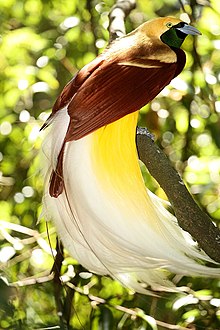The lesser bird-of-paradise (Paradisaea minor) is a bird-of-paradise in the genus Paradisaea.
| Lesser bird-of-paradise | |
|---|---|

| |
| Male | |

| |
| female | |
| Scientific classification | |
| Domain: | Eukaryota |
| Kingdom: | Animalia |
| Phylum: | Chordata |
| Class: | Aves |
| Order: | Passeriformes |
| Family: | Paradisaeidae |
| Genus: | Paradisaea |
| Species: | P. minor
|
| Binomial name | |
| Paradisaea minor Shaw, 1809
| |
Description
editThe lesser bird-of-paradise is medium-sized, up to 32 cm (13 in), maroon-brown with a yellow crown and brownish-yellow upper back. The male has a dark emerald-green throat, a pair of long tail-wires and is adorned with ornamental flank plumes which are deep yellow at their base and fade outwards into white. The female is a maroon bird with a dark-brown head and whitish underparts. Further study is required,[2] but it seems likely that birds-of-paradise also possess toxins in their skins, derived from their insect prey.
It resembles the larger greater bird-of-paradise, but the male of that species has a dark chest, whereas the female is entirely brown (no whitish underparts).
Breeding
editThe males are polygamous, and perform courtship displays in leks. The female usually lays two pinkish eggs with dark markings in a nest in a tree high above ground. Its diet consists mainly of fruits and insects.
Distribution
editThe lesser bird-of-paradise is distributed throughout forests of northern New Guinea, and the nearby islands of Misool and Yapen. Widespread and common throughout its large range, the lesser bird-of-paradise is evaluated as Least Concern on the IUCN Red List of Threatened Species. It is listed on Appendix II of CITES.
References
edit- ^ BirdLife International (2018). "Paradisaea minor". IUCN Red List of Threatened Species. 2018: e.T22706245A130413448. doi:10.2305/IUCN.UK.2018-2.RLTS.T22706245A130413448.en. Retrieved 12 November 2021.
- ^ Venomous Animals of the World, Steve Backshall; 2007, New Holland Publishers (UK), Ltd.
External links
edit- Explore Species: Lesser bird-of-paradise at eBird (Cornell Lab of Ornithology)
